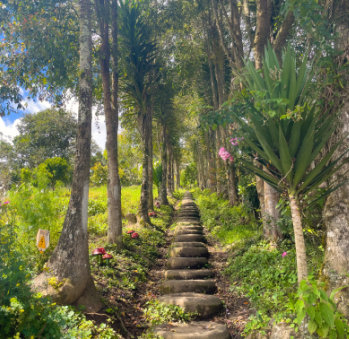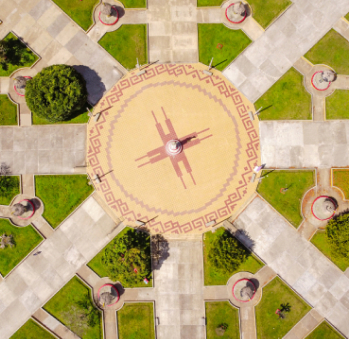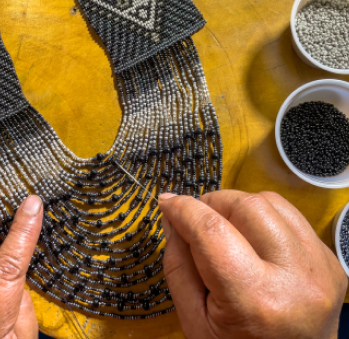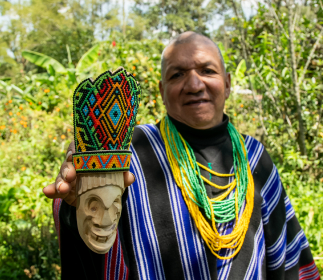Putumayo Route
To arrive in the Alto Putumayo is to step into another dimension. This Andean-Amazonian landscape allows us to uncover the meaning behind its biological corridor, its fauna and flora. This region is also the home of several indigenous communities —mainly the Kamentsa and Inga— who honor it by growing plants, singing, and generally taking care of it. The power of their religious syncretism and the strength of their spirituality is transmitted by every one of their craftspeople. An essential step of their creative and healing processes is drinking their “medicine” (yagé). It lets them grasp everything they need to understand. This trip will give you the opportunity of immersing yourself in a deep, healing world. It will also let you discover the chagras: customary gardens where vegetables and medicinal plants that are prepared to embark in introspective spiritual journeys are grown. The craftspeople of this ancestral trail are very skillful. They are authority figures in their communities. Many of them are elders who have accumulated life experience and who know the wisdom that comes from words. These elders and their heirs are the proud bearers of their unique knowledge. They will openly tell you what their work means to them. It is a channel through which they elevate their souls, look after the bodies of women who will give birth, and record the symbols of their people. A wonderful date in which to visit the region is during Ash Wednesday, toward the end of February. If you come at this time you will be able to celebrate the Big Day —also known as the Carnival of Forgiveness— with the community, which commemorates the arrival of the indigenous new year.
Embark on a journey full of history

Artisans along the way
Artisans along the way
We recommended this tour
Schedule the visit in advance with the artisans.
Carry cash.
3.5 days
Car or Bus

Sibundoy
You can travel to Sibundoy either through Pasto (64,6 km) or through Mocoa (82 km). If you choose the former route, the trip will last two hours; if you choose the latter, it will last three and a half. This is the epicenter of the Kamentsa world, where the Big Day —also known as the Carnival of Forgiveness— is celebrated. Here, you will find grandmothers who bare the knowledge of their trades and the history of their people. Their hands have the power to weave and to heal. This is an exceptional place to witness how Catholicism and indigenous beliefs are able to coexist in harmony. This can be seen in the great faith of the community’s craftswomen, as well as in the Multiculturalism Park. The latter is a place that hosts both an enormous stone cross and eight wooden sculptures that depict indigenous beliefs and customs such as woodcarving, and the drinking of yagé. Do not miss out on the traditional indigenous food market, although none of its dishes will even come close to matching what you will be able to receive firsthand from the townsfolk. Every master craftswoman will bring you an unending amount of hospitality that, amidst its modesty, will be compensated by the incredible connection you will be able to establish if you choose to drink the “medicine” by their side. Everything is close by in this route, which will make transport a breeze. That being said, we recommend you slow down and give yourself three days to live the experience alongside these wisemen without any rush: watch them weave and carve, listen to their knowledge, and understand yagé permeated in its context, preparation, ceremony, and healing.
San Francisco and Colón
To arrive in Colón you will pass by San Francisco, 6 kilometers away from Sibundoy. Some minutes later, you will arrive through the outskirts of the town of Colón, you can meet Sandra Isabel Chasoy and learn firsthand what it means to be a member of the Inga community. She will patiently and warmly explain to you every one of her culture’s rich symbols. Colón is surrounded by plentiful natural environments, which are all worth a stop. If you want to have a transformative experience, visit the Ambiaku hot springs. Their name means “medicinal water” in the Inga language. If you have the time, you should take the long, rugged hike to El Salado: a stream in which hot and cold water meet. We guarantee you will be impressed. You can also go to Sumayaco —also called “Río Bonito”—, the perfect place to go canoeing or travel the valley’s waters and see its wetlands and reserves. To finish off, it is essential to stop for a moment at the San Sebastián Viewpoint, where you will be able to admire the magnificence of the entire Sibundoy Valley staring at it from above.


Santiago
Santiago is also right beside Colón, 6.6 kilometers away. There, you will discover the magnificent Jacanamijoy house. It belongs to a family of artists and craftspeople who have dazzled the country for years. You will be able to witness how these warm hosts weave and grow their crops. We recommend you finish your trip surrounded by nature. When you embark on your return to Pasto, we invite you to go see the Bordoncillo or Quilinsayaco Paramo, about 20 minutes away from Sibundoy. It is a wildlife reserve that is perfect for birdwatching. Its water sources are generous and around 26 micro basins flow into the Quinchoa River. We also suggest walking around the Indipayaco or Sol lagoon: the perfect place to relax and connect with nature. A word of advice, however: this is not a trip to take between the months of November and February, since this is when the region’s dry season takes place.

Traditional cuisine
and typical bites
Provoke yourself

Don't leave without eating this 
Grilled Guinea Pig: The guinea pig, a small rodent once called conejillo de indias by the Spanish, is highly prized for its meat. In Sibundoy, you can find it at Singa Cuy, where it’s grilled for about two hours, resulting in a crispy, cracker-like skin. It’s served with boiled potatoes, popped corn, pumpkin seeds, yotas, and chili peppers. The dish is enjoyed alongside a stunning landscape of lush vegetation and a varied menu featuring garden-fresh products and the delicious pirarucú fish from the Amazon.
To lunch we go 
Bishana: A spicy soup made primarily with cabbage (bisha), and other local produce such as corn, choclo (young corn), squash, tranca beans, beef broth, heart of palm, and chili peppers. It’s a daily meal for the Kamentsá community and provides a lot of energy. There are four varieties of Bishana, depending on the type of corn used: tender corn (choclo), ground and toasted corn, or just ground corn. Artisans like Carmela Agreda prepare this dish for visitors, but it’s necessary to make a reservation a few days in advance. You can also order mote with chicken, corn envueltos filled with tranca beans stew, or mote envueltos .
Flavors to discover and snack on 
Discover the range of fruits native to the area, which have recently gained recognition, such as lulo, granadilla, arazá, cocona, Amazon guava, chimbalo, chilacuan, chontaduro, and tree tomato. These fruits are used to make refreshing drinks, jams, and preserves boasting exotic flavors. You can sample them at the market squares in the towns along this route.
Choclo Envueltos: Corn is finely ground, mixed with salt and sugar, and wrapped in achira leaves. These leaves are often used to wrap food, giving it a distinct flavor, and are also used in salads. The wraps are steamed and can be served with fresh cheese.
Corn or Mote Envueltos: The corn is finely ground and filled with mashed tranca beans, minced meat, garlic, and chili. These are also steamed.
To sweeten the palate and unmissable drinks 
Chilacuan Jam: A variety of papayuela, this is cooked with cinnamon, cloves, panela, uvillas, and blackberry. It’s served with fresh cheese, bread, or aco (finely ground and toasted corn).
Pumpkin Jam: Made with panela and cinnamon, sometimes with seeds that taste like coconut.
Corn Chicha: A traditional fermented drink made from corn. In Alto Putumayo, chicha is also made with pineapple, poleo, or tubers such as arracacha, yam, yota, tumaqueño, and achira. Artisan Doris Jajoy offers this drink, along with colada de maíz (corn drink with naranjilla), a breakfast beverage made with ground corn, naranjilla, and panela.
Chucula: A drink that can be served cold, made from cooked green or yellow plantain, honey, and chicha.
Cocona Juice: cocona is a native Amazonian fruit with a sweet-sour flavor. It can be eaten fresh or made into a juice.
Motilón: We recommend the artisan wine from TAMNY, made from the fruit of a tree of the same name, which produces a purple dye. It has an alcohol content of 7% and a sweet-sour flavor. You can purchase this drink from Milena Aguillón at the Iraca Foundation.
Other local delights 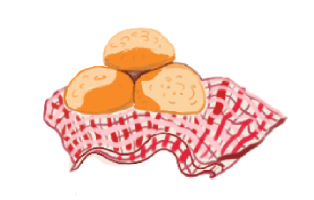
Chicken Mote: A delicious soup made with corn treated with lye to peel it, then cooked with chicken broth, pork, guinea pig, and tranca beans.
Tender Corn Soup: Made with tranca beans, arracacha, meaty bone, egg, and chili, this dish is typically served during celebrations.
Locro: A vegetarian dish made with cabbage, cuna, squash, tranca beans, and fava beans.
Recommended sites
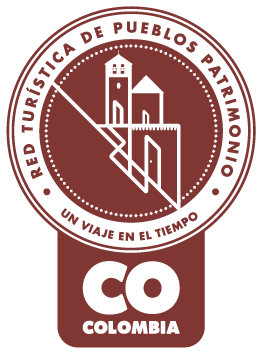
Pueblo Patrimonio
La Red Turística de Pueblos Patrimonio de Colombia es un programa especial del Ministerio de Comercio, Industria y Turismo, ejecutado por FONTUR, que trabaja con 17 municipios de Colombia que poseen declaratoria de Bien de Interés Cultural (BIC) a nivel nacional para su valoración y proyección mediante el turismo, generando así más oportunidades de desarrollo y sostenibilidad en las comunidades.

La Medalla a la Maestría Artesanal es un galardón que Artesanías de Colombia entrega anualmente, con el cual se hace un reconocimiento a aquellos artesanos, empresas y comunidades artesanales que, contando con una trayectoria destacada, sobresalen a nivel nacional por su excelencia en el oficio así como por preservar el quehacer artesanal.

Denominación de Origen
Es un signo distintivo que identifica productos reconocidos o famosos por tener una calidad o características específicas derivadas esencialmente del lugar de origen y la forma tradicional de extracción, elaboración y producción por parte de sus habitantes. La protección conferida sobre una Denominación de Origen implica que ninguna persona puede identificar con la denominación protegida productos iguales o similares a los amparados, cuando no provengan del verdadero lugar y no cumplan con las características o calidades que le han dado la reputación al producto reconocido. Las Denominaciones de Origen para productos artesanales colombianos que han sido protegidas por la Superintendencia de Industria y Comercio en nuestro país son actualmente 12.
No puede copiar contenido de esta página









































